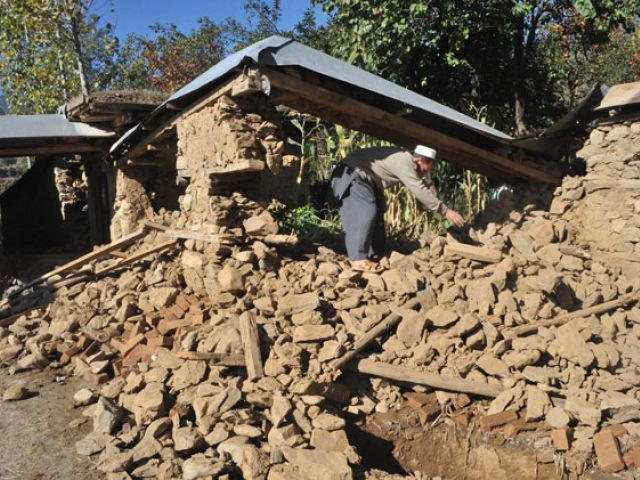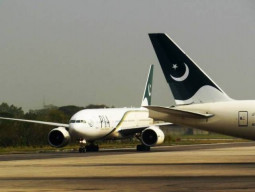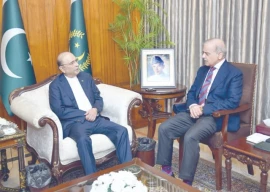
Though authorities are engaged in rescue efforts in areas affected by the earthquake in both Khyber-Pakhtunkhwa and the Federally Administered Tribal Areas (Fata), damages are still being accounted for. Some affected regions are still inaccessible as roads were rendered useless by landslides. Some survivors are left with no option but to destroy whatever remains of their damaged houses as what stands could collapse – no one wants to take the risk.
With the media watching every move, everyone from the prime minister to the president has been travelling to not just “photo ops” at hospitals but also to far-flung districts such as Chitral, Shangla and Dir and into the borderlands of Bajaur Agency. Prime Minister Nawaz Sharif and Chief Minister Pervez Khattak’s coordination has been seen as an encouraging sign by those who lost loved ones or saw their lifelong investment turn to rubble on October 26. Big names like Imran Khan or Sirajul Haq and leaders who have roots in Khyber-Pakhtunkhwa such as Ameer Haider Khan Hoti of Awami National Party, Aftab Ahmad Khan Sherpao and Amir Muqam of Pakistan Muslim League-Nawaz are also seen highlighting and addressing miseries of survivors.
Then and now
Compared to the October 8, 2005 quake, damages to both life and property were fewer in the recent 7.5 magnitude quake. Experts have hinted at different reasons for it. It could even be said the main reason for less destruction was a combination of timing and awareness among people living along fault lines.
The seismic activity on October 8, 2005 occurred at a time when most people were indoors, either eating breakfast or still asleep. A majority of the victims were school going children who were present in classrooms. This time, when the earth shook it was early in the afternoon. Most people, including children, were outdoors, in the streets and fields.
Similarly, after October 8, 2005, the practice of using concrete in construction saw an upward trend. This possibly resulted in less of a loss.
Need for better data
According to the Provincial Disaster Management Authority’s (PDMA) data from October 28, 220 people lost their lives in the recent earthquake in the province. The PDMA data suggests over 12,000 houses and schools were damaged.
The National Disaster Management Authority (NDMA) states 271 people died across the country (this includes two in Azad Kashmir) and 2,158 were injured. This data does not elaborate on how many public properties like schools, hospitals, offices and others were damaged or destroyed in the earthquake. It estimates the destruction of 9,534 houses in all of Fata, of which 8,184 are reported to be in Bajaur Agency.
However, more recent reports pouring in from affected regions reveal even more has been lost. Based on that, politicians and social workers are insisting on a more thorough survey.
Jamaat-e-Islami’s provincial ameer Mushtaq Ahmad Khan has reservations over the damages presented by the federal and provincial data. Mushtaq pointed out there was widespread destruction in all seven districts of Malakand Division. Awami National Party Khyber-Pakhtunkhwa Secretary General Sardar Hussain Babak holds a similar view after he travelled to his native district of Buner. Babak said, “There is definitely more destruction – thousands of people are now homeless. Even more as people are tearing down houses that are now too risky to live in.” Similar reports are coming in from both Bajaur and Kurram agencies where children are now too scared to sleep under a roof lest it shake.
Irrespective of rifts and rivalries, almost all politicians and office holders of political parties are not only insisting on carrying out more through assessment surveys but are also joining hands to conduct relief activities. Mushtaq Ahmad believed, “One political party or provincial government cannot cope with this situation.” He added, “A strategy should be drawn after mutual consultation.” Muqam and Aftab Sherpao have given similar suggestions.
Not enough
The public in general is not happy with the money given as compensation to survivors. Both federal and provincial governments fixed Rs600,000 for heirs of each deceased, Rs200,000 to those badly injured and Rs100,000 to those with minor injuries. It was said Rs200,000 would be given to owners of those houses that were destroyed and Rs100,000 to owners of partially damaged homes.
After taking into account the existing prices of materials, the money being given will hardly cover costs. Similarly, political workers and elected representatives are also unhappy with the money being given to families of the deceased and to those injured. Both Mushtaq Ahmad and Hoti denounced the amounts and demanded a reasonable increase.
Published in The Express Tribune, November 2nd, 2015.












COMMENTS
Comments are moderated and generally will be posted if they are on-topic and not abusive.
For more information, please see our Comments FAQ